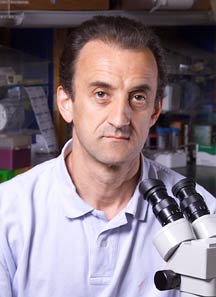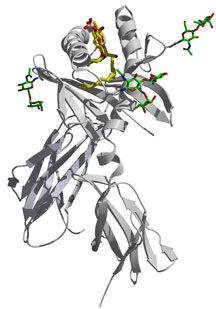

Here's looking at you, CD1
By Jason Socrates Bardi
There are two famous lines from the classic 1942 Humphrey Bogart and Ingrid Bergman film Casablanca—well, three really, but "Play it again Sam" was never actually uttered in the film.
Depending on what one looks for in a film, one is likely to remember one or the other. People who love the romantic love-and-loss aspects of the film will recall Bogart's solemn goodbye: "We'll always have Paris." And those who appreciate the gritty film noir plot will probably remember the closing line: "I think this is the start of a beautiful friendship."
For Associate Professor Luc Teyton of The Scripps Research Institute and Albert Bendelac of the University of Chicago both lines seem appropriate. Their long-standing scientific collaboration has its roots in Paris, where they knew each other as students before they both came to the United States and settled in distant corners of the country.
In the years since, the Teyton and Bendelac laboratories have made a number of collaborative discoveries related to an immune cell, known as a natural killer (NK) T cell, or "NK1.1 T cells," which regulate other immune cells.
They have been trying to understand how the NK1.1 system works for a number of years.
Results of their latest collaboration are being published in the journal Science, where Bendelac, Teyton, and their colleagues report that they have discovered the first natural, endogenous lipid that is recognized by NK1.1 T cells.
Strange Cells Reveal Mysteries
NK1.1 T cells are unusual in that they fall somewhere between innate and adaptive immunity. These cells arise in the thymus, and as mature cells, they stimulate an adaptive immune response and regulate a range of disease states, including diabetes, cancer, and pathogenic infections.
Evidence for the cell's role in cancer can be seen in studies of mutant mice that are lacking NK1.1 T cells. These mice have a higher incidence of cancer, but if the deficient mice are transplanted with NK1.1 T cells, their prognosis much improves.
NK1.1 T cells are also involved in the innate immune response and are one of the first cells in the immune system to respond to many types of infections. Once the NK1.1 T cells become activated, they begin to secrete a large amount of two proteins—interferon-gamma, which activates macrophages, and interleukin-4, which activates helper T cells. The macrophages and the helper T cells then carry on the immune response by engulfing other cells and inducing specific B cells to unload bursts of soluble antibodies into the bloodstream. These antibodies ultimately deal with the pathogens.
Like other T cells, NK1.1 T cells express T cell receptors (TCR)—although without the normal antigenic variability. However, NK1.1 T cells vary from other T cells lines in that they also express the "NK" receptors, which are normally associated with cells of the innate immune system and are used to detect some of the lipids that many bacteria display on their outer surface.
Curiously, NK1.1 T cells are the only cells in the immune system that also can detect "endogenous" lipids made in the body. This is because NK receptors recognize a receptor on the surface of antigen-presenting cells called CD1, which have the ability to display native lipids.
For a number of years, scientists have been looking for these native lipids on CD1 to which NK1.1 T cells bind because they are presumably involved in controlling the action of NK T cells in the body. One focus of Teyton and Bendelac's investigations has been to discover what these mysterious ligands are.
Now they have found one.
Using genetic tools, they were able to demonstrate that a lysosomal glycosphingolipid of previously unknown function called "isoglobotrihexosylceramide" or iGb3 is recognized both by mouse and human NKT cells when it is presented by CD1. Previously, nobody knew what ceramide lipids do in the body, and this is the first time that a function has been assigned to any lipid in the ceramide pathway.
In their study, Bendelac, Teyton, and their colleagues also report that iGb3 deficiencies in mice result in NK T cell deficiencies, which suggests that the lipid mediates development of NK T cells.
The research article, "Lysosomal Glycosphingolipid Recognition by NKT cells" is authored by Dapeng Zhou, Jochen Mattner, Carlos Cantu III, Nicolas Schrantz, Ning Yin, Ying Gao, Yuval Sagiv, Kelly Hudspeth, Yunping Wu, Tadashi Yamashita, Susann Teneberg, Dacheng Wang, Richard Proia, Steven B. Levery, Paul B. Savage, Luc Teyton, and Albert Bendelac and appears in Sciencexpress on November 12, 2004. Sciencexpress provides rapid electronic publication of selected papers in the journal Science. Print versions of these papers will appear in Science after several weeks. See: http://dx.doi.org/10.1126/science.1103440.
The research was funded by the National Institutes of Health, by two CRI fellowships, and by the New Hampshire Biological Research Infrastructure Network-Center for structural biology.
Send comments to: jasonb@scripps.edu

Investigator Luc Teyton (above) has contributed to a number of discoveries related to an immune cell, known as a natural killer (NK) T cell, or "NK1.1 T cells," which regulate other immune cells. Photo by BioMedical Graphics.

One of the structures recognized by NK T cells. Image by Dirk Zajonc.
